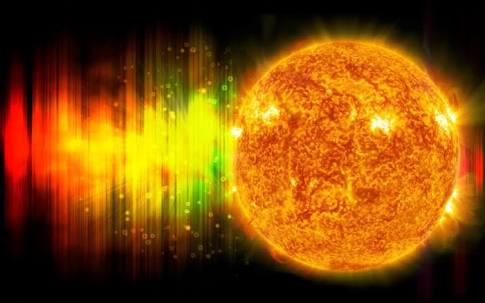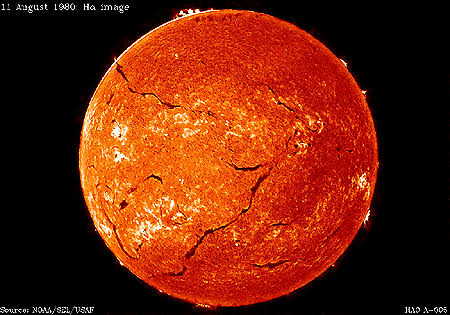To The End Of The Tunnel And Beyond; The Journey Of Light
.jpeg)
Image
Ah…the sun, our big red fiery monster up there in the sky. If you could look beyond the rage and fury with which this gigantic nuclear reactor constantly hurtles radioactivity our way, you will find a big-hearted benefactor a hundred and fifty million (150, 000, 000) kilometers away constantly supplying us with the light, heat and energy necessary for life itself and everyday living on our planet and the entire solar system.
Did you know that if the sun were to be somehow stolen (say I don’t know…aliens), or some unsupervised intern were to pull the plug or flip the wrong switch, it would take 8 minutes and 20 seconds before we would notice? Gasp!!! The horror!
That’s because it takes a photon (a discrete bundle or quantum of electromagnetic or light energy known as a light particle or ray of light) leaving the surface of the sun at 300,000 kilometers per second (the speed of light) about 8 minutes and 20 seconds to get to earth.
To all the doomsday and apocalypse survivalists out there, the time to beat is 8 minutes. How fast can you get to your sweater?
Now back to the photon, we’ve already established the time it takes it from the sun to the earth, but do you know how long it takes it to get to the surface of the sun from the suns core where it is produced? Take a guess, a very wild one. You could take a million years and still miss it, so let me explain.
Our sun is basically a nuclear fusion reactor with a radius of over 700,000 kilometers consisting of different layers with temperatures varying from 15, 000, 000 at the core to about 2, 000, 000 at the chromosphere and corona. It’s surface brightness is 398,000 times more than that of the moon, so I’d scratch it off the list of things to use for a stare match.
The layers of the sun include:
The Core/Nucleus
This is where nuclear reactions occur, the fusion of hydrogen ions, which is the life of the sun itself. Produces about 380 billion megawatts of energy and consumes 4 million tons of hydrogen per second. It is about 138, 403 km wide.
Radiation Zone
This region is 300,000 km thick, and consists of dense ionized gas under constant bombardment by the gamma rays released as a result of the hydrogen proton fusion in the core below, these gamma rays bounce off the gas, are absorbed and re-emitted as X-rays and UV radiation
Convection Zone
Spans 200,000 kilometers immediately below the photosphere, constitutes the outermost 30 percent of the Sun’s interior. Heat transfer is primarily by convection: Hot bubbles formed deep inside, bounces between the hot interior and cooler exterior rising to the surface (creating granules and super granules), cools and then re-enters the zone.
Photosphere
A 400-km layer of low density, observed as granulated with plasma granules rising and falling, where matter is constrained along magnetic lines. It is responsible for the energy enveloping the planets. A greater amount of the visible light from the sun originates from this region. Solar flares and sunspots are characteristic of this region.
Chromosphere
Around 2000-km thick semitransparent layer where protrusions are formed during ejection of matter from the sun’s atmosphere. It is the rosy red layer of the sun seen during eclipses.
Corona
Seen during eclipses as the visible white layer which are plumes of ionized gas flowing outwards into space. It changes shape due to gas emissions, with no upper limit. It is hotter than the two preceding layers.
The Journey
The Sun generates its energy at the core, through a step known as the proton-proton chain. A three-step fusion process occurring readily in the extreme conditions of the core (at temperature of 15,000,000 ºC and a density of 150 g/cm3), which causes the hydrogen atoms constituting most of the Sun’s mass to have too much energy, they split into their component parts: protons and electrons; creating plasma.
During the proton-proton chain, the collision of two protons forms a deuterium (2H), positron (e+), and neutrino (ve). A proton then collides with deuterium to produce helium-3 (3He) and a gamma ray.
This gamma ray is our photon (a super energized one) conveying the energy produced by the sun’s nuclear fusion as light particles and heat. After creating the photon, two helium-3 nuclei combine to create a helium-4 nucleus, and two protons. For the third and final step, two helium-3s (3He) collide to produce a neutral helium nucleus (4He) and two protons. Ending the proton-proton chain also called nuclear fusion.
Our photon leaves the core and enters the radiative zone which is just beyond the core of the Sun, so named due to its main method of energy transport: the radiation of light (x-ray and UV rays). Almost 50 percent of the interior of the sun, it transports energy in the form of photons or light. Consisting of densely packed protons so squeezed together, photons keep bumping onto each other, losing some of its energy and scattering in a random direction as a result.
Although traveling at the speed of light, our photon could take up to a few million years to navigate the radiative zone. Bouncing around endlessly, unable to follow a straight path due to the immense density of the layer. Scientist call this “the photon random walk”.
Talk about going nowhere fast!
After escaping the radiation zone, our photon having lost much of its energy and shifting into the visible spectrum, enters the convection zone. Here, the primary heat transfer process is via convection, with hot material (granules and super granules) rising to the upper edge of the zone due to its lower density and then gives off its heat, cools and sinks back to the lower edge of the zone to repeat the cycle. This behavior is in conjunction with the ideal gas law.
Due to the lower temperature of the zone, our photon gets absorbed into the gas bubbles and is released into the photosphere as the bubble heats up and rises.
On entering the photosphere, our photon is now in the visual spectrum of light and due to the very low density of this region (the sun’s atmosphere), there are few interactions on its way out of the photosphere. It enters into the chromosphere and through the corona where dust and a few atoms might still scatter it to different direction.
At the edge of the corona, it takes our photon just 8 minutes 20 seconds to get across the 15 million km vacuum between the sun and the earth. If it isn’t interrupted by satellites or falls on other physical structures, it hopefully makes its way to our retina which absorbs it and sends an electric signal to our brain (this is how we perceive light).
Summary
The next time you look to the end of the tunnel, remember the light you see there has been a long time coming. I’m sure there’s a life lesson in there somewhere.
Spare a thought for those photons that goes through this rigorous process only to end up in a blackhole.
References
astronoo.com
dujs.dartmouth.edu
science.jrank.org
sciencing.com
futurism.com
phys.org
nasa.gov
.jpeg)
.jpeg)
.jpeg)

Being A SteemStem Member
I lloovveee thisss posstt I am a physics major and things like this definitely gets my attention. Thanks for posting this @jajdgenius definitely following you now;)
What people dont understand is that the light that we see from stars are the memories of the past. Eventhough we know that our star, SUN will someday lose its light we are still happy that we are given the chance to live this life share our own light and do the best out of it...
Thanks for like my post my friend and I'll surely follow you back. Also, thanks for your kind words, I'm honored... 😀 😀 😀